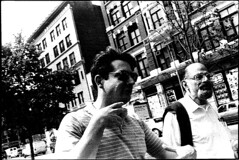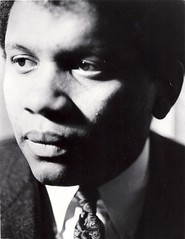 Paula Litsky Bob Rosenthal at Ginsberg’s funeral.
Paula Litsky Bob Rosenthal at Ginsberg’s funeral.It’s the last day of National Poetry Month, so here’s the final installment of our interview with Bob Rosenthal, conducted at Allen Ginsberg’s old 12th Street apartment, where Mr. Rosenthal worked as his secretary for nearly two decades. (Parts one, two, and three of this leisurely conversation ran last week.) As Ginsberg grew older and ill, his assistant followed him to a 14th Street loft purchased from the painter Larry Rivers; when Ginsberg died in 1997, Mr. Rosenthal became executor of the poet’s estate and guardian of one of his last meals.
Allen’s Addictions
Allen always had some pot around – he was a pot propagandist and so if a joint was being passed around and someone was going to take a photograph he would grab the joint so he’s got it. But actually, I rarely ever saw him smoke. He had pot for boyfriends – it’s a good line: “Oh, you want to come up and smoke?” It was really for them. He would go to LSD conventions with the big guys – the Fitz Hugh Ludlow Library guys, Huxley and all those guys. They would give him acid and he would come home and put it in the refrigerator and that was cute. There was a little vial of LSD and it said “Do not take without permission of Allen or Bob” – so I guess Bob had permission. So that was nice. But I never saw him on LSD. Read more…
 Rosenthal and Ginsberg.
Rosenthal and Ginsberg.Earlier this week, Allen Ginsberg’s secretary of 20 years, Bob Rosenthal, shared memories of his former employer – some of which will be included in a memoir he recently completed, “Straight Around Allen.” Speaking to The Local at Ginsberg’s former apartment on East 12th Street, where the two worked alongside each other for so long, he recalled the great poet’s daily routine, his tastes in literature and music, his mail and telephone communications, and his ways with money. Today, in our second installment, Mr. Rosenthal talks about Ginsberg’s social sphere during his two decades in the so-called poets building. Check back tomorrow for still more from this candid interview.
Allen’s East Village
People would always call Allen and say, “Allen, come to my shangri-la in Hawaii,” and here or there. He would never go. A vacation for Allen was coming back and having nothing to do in the East Village. He would often go to the poetry readings at St. Mark’s. He loved the mushroom barley soup at the Kiev. And The New York Times – he just loved it. He hung around Tompkins Square, wrote a lot of one-line poems about skinheads there. And he was a natural. I think because he always felt free here. Read more…
Last weekend, in one of our posts celebrating The East Village Other, Ed Sanders wrote that poet Ted Berrigan may have named the alternative newspaper after the Rimbaud line “I is an Other.” Mr. Sanders acknowledged, “Another account has Ishmael Reed coining the name.” In the comments, EVO editor Peter Leggieri wrote that Allen Katzman (who founded the paper along with Dan Rattiner and Walter Bowart) “always gave the impression that he had suggested the name ‘Other.'” After citing the reasons, Mr. Leggieri wrote, “However, if the question of origin came to a vote, I’d probably pull the lever for Ishmael Reed.” Here, now, is Mr. Reed himself, on his role in shaping The East Village Other.
 Isamu Kawai Ishmael Reed, 1967
Isamu Kawai Ishmael Reed, 1967My receiving a job as the editor of a newspaper in Newark, N.J., led to the origin of The East Village Other. I worked a number of temporary jobs from the time I arrived in New York in the fall of 1962 until I left for California in the summer of 1967. One of those jobs was that of a pollster for The Daily News. So when I went to the Department of Labor to get a temporary job, after the poll was completed, I was informed of an opening for a reporter for a new newspaper in Newark.
I had written for a newspaper in Buffalo called The Empire Star, edited by the great A.J. Smitherman, who was the target of mob violence during one of the worst riots in American history, the Tulsa riots of 1921, which left 300 blacks dead.
Smitherman believed in armed self-defense against lynching. After an interview with the investors, it was decided that I would be the editor of a newspaper that I named Advance. Although I had watched the production of a newspaper using the old linotype method while working for the newspaper in Buffalo, I hadn’t a clue about offset printing.
Walter Bowart was a bartender at Stanley’s, which was our hangout. It was owned by Stanley Tolkin who was a patron of the arts and our benefactor. Read more…







